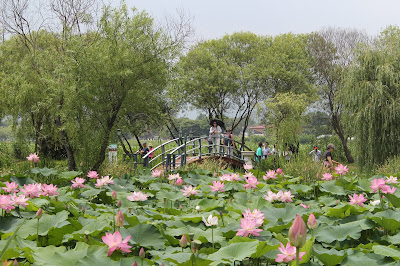The most beautiful blooming time of Lotus in a day is in
the morning rather than in the afternoon, as I heard. So I started my home
early morning with my family. Usually it starts blooming in late June, matures in July
and lasts till around mid-August. I always wonder how it blooms flower and seed
at a same time, to be surprised.
This famous lotus garden ‘Semiwon’ (세미원) in Yangpyeong(양평) is located right next to east side of Seoul, surrounded by
the Hangang river. So it is so easily accessible from Seoul or the neighboring metropolitan cities of the capital by car, bus and subway. Yangpyeong is also
famous for the first officially certified organic cultivation zone in the country. It started
as a small lotus garden in May 2004, became larger and larger as times go by
and now leads up to 56000 square meters in the size. The government funding aiming
for the natural purification properties enabled its’ scale up in wide range of
areas. With these steady,elaborate and careful efforts, this now became to end up an tourist attractions where over 400,000 people has visited annually and has increased day by day. It consists of various kinds of lotus gardens, fountains, environment learning center, trial cultivation complex, observation pavilion and greenhouse etc. At the entrance wall, it was written ‘the garden of water and flower’ and eye-catching beautiful lotus relief represents the oriental image. Through this beautiful wall, we stopped by the lotus museum on the right side at first with curiosity. On the 2nd floor, simple but elegant lotus-themed items were shown.
 |
| Semiwon(세미원); the garden of water and flowers |
 |
| Lotus flower pattern on the Korean traditional roof tile in the lotus museum |
Each single one enough evoked my admiration to this lovely heaven spots and blew off my awkward thought that why it blooms so this hot day that it will be somewhat hard to see the flowers under strong sunshine. What’s more, thanks to low wooden benches to sit on,benches and pavilion scattered here and there, we avoided early summer heat, drank water prepared ( tip; please carry enough water for your thirst) and took brief break on the low wooden bench.
Have you ever seen the lotus flower? I was surprised at the big size of flower almost as big as your face and giant leaf as big as enough to be able to sit on it. I did not boring at all because my heart was stolen by the flowers while I didn’t recognize.
 |
| fountains being motivated from Korea traditional storage crocks |
 |
| Path for your heart cleaning ,covered by the shape of Korea traditional washboards |
 |
| Old pine tree in front of Sehanjeong pavilion(세한정) |
 |
| Painting Sehando in the Sehanjeong pavilion |
 |
| Boat bridge connecting between lotus garden and Dumulmeori People can across this bridge only when lotus garden opens |
1.
Take Gyeongui Jungang subway(경의중앙선)..bound for Yongmun st.(용문역), not bound for Deokso. >> took off at Yangsu st.(양수역), exit1 >> go straight ahead **Check subway service interval for your return because it
operates a half-hourly service in general *** best choice
2.
Take bus no.167 from Cheongnyanggni(청량리역 subway line1) >> off at Yangseo
cultural sport park(양서 문화체육공원) in Yangsuri(양수리)
3.
Take bus 2000-1 at Gangbyeon st( 강변역subway line2) >> off same of above 2nd
point.





















0 개의 댓글:
댓글 쓰기